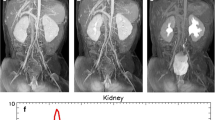Abstract
We used the fast field-echo technique of magnetic resonance (MR) imaging with an intravenous bolus injection of paramagnetic contrast agent to evaluate glomerular function. The time-dependent curves of changes in signal intensity observed in the renal cortex and renal medulla brought about by the paramagnetic contrast agent allowed insight into excretory kinetics. The time at which the cortical and medullary curves cross, the cortico-medullary (C-M) junction time, was delayed with a decrease in glomerular function. The mean C-M junction time in both kidneys showed a significant inverse correlation with total creatinine clearance (Ccr), indicating the glomerular filtration rate. The C-M junction time in an individual kidney also showed an inverse correlation with individual Ccr in each kidney. Results suggest that dynamic MR imaging is a useful tool in evaluating renal morphology and in evaluating semi-quantitatively the glomerular function of the kidneys, singly and together, in a manner analogous to radionuclide scintigraphy.
Similar content being viewed by others
References
Hricack H, Crooks L, Sheldon P, Kaufman L (1983) Nuclear magnetic resonance of the kidney. Radiology 146: 425–432
Thickman D, Kundel H, Biery D (1984) Magnetic resonance evaluation of hydronephrosis in dog. Radiology 152: 113–116
Terrier RF, Hricak H, Revel D, et al (1985) Magnetic resonance imaging in the diagnosis of acute renal allograft rejection and its differentiation from acute tubular necrosis: experimental study in the dog. Invest Radiol 20: 617–625
Yuasa Y, Kundel HL (1985) Magnetic resonance imaging following unilateral occlusion of the renal circulation in rabbits. Radiology 154: 151–156
Hircak H, Terrier F, Demas BE (1986) Renal allografts: evaluation by MR imaging. Radiology 159: 435–441
Carvlin MJ, Arger PH, Kundel HL, Axel L, Dougherty L, Kassab EA, Moore B (1987) Acute tubular necrosis: use of gadolinium-DTPA and fast imaging to evaluate renal function in the rabbit. J Comput Assist Tomogr 11: 488–495
Kikinis R, von Schulthess GK, Jager P, Durr R, Bino M, Kuoni W, Kubler O (1987) Normal and hydronephrotic kidney: evaluation of renal function with contrast-enhanced MR imaging. Radiology 165: 837–842
Carvlin MJ, Arger PH, Kundel HL, Axel L, Dougherty L, Kassab EA, Moore B (1989) Use of Gd-DTPA and fast-gradient-echo and spin-echo MR imaging to demonstrate renal function in the rabbit. Radiology 170: 705–711
von Schulthess GK, Kuoni W, Gerig G, Wuthrich R, Duewell S, Krestin G (1991) Semiautomated ROI analysis in dynamic MR studies. Part II: application to renal function examination. J Comput Assist Tomogr 15: 733–741
Takeda M, Katayama Y, Sato S, Odano I (1990) Value of dynamic magnetic resonance imaging in hydronephrosis. J Urol 143: 258A
Togami I, Murakami K, Tsunoda M, Kitagawa N, Sato N, Kimoto M (1991) Evaluation of renal function using dynamic MRI with Gd-DTPA — comparison with dynamic CT and renogram using 99mTc-DTPA on normal volunteer. Jpn J Med Imaging 10: 138–146
Felix R, Schorner M (1985) Brain tumors: MR imaging with gadolinium-DTPA. Radiology 156: 681–688
Ohtomo K, Itai Y, Yoshikawa K (1987) Hepatic tumors: dynamic MR imaging. Radiology 163: 27–31
Fuchs WA (1989) Renal morphology and function in magnetic resonance imaging. In: Margulis A (ed) Morphology and function in MRI. Springer, Berlin Heidelberg New York, pp 111–131
Mirowitz SA, Brown JJ, Joseph KT, Heiken JP (1991) Dynamic gadoliniumenhanced MR imaging of the spleen: normal enhancement patterns and evaluation of splenic lesions. Radiology 179: 681–686
Takeda M, Katayama Y, Tsutsui T, Komeyama T, Mizusawa T (1994) Does gadolinium-diethylenetriamine pentaacetic acid enhanced MRI of kidney represent tissue concentration of contrast media in the kidney? In vivo and in vitro study. Magn Reson Imaging 12: 421–427
Weinmann HJ, Brasch RC, Press WR, Wesbey GF (1989) Characteristics of gadolinium-DTPA complex: a potential NMR contrast agent. AJR 142: 619–624
Frank JA, Choyko PL, Austin HA, Girton ME (1991) Functional MR of the kidney. Magn Reson Med 22: 319–323
Krestin GP (1994) Magnetic resonance imaging of the kidneys: current status. Magn Reson Q 10: 2–21
Lorenz CH, Powers TA, Partain CL (1992) Quantitative imaging of renal blood flow and function. Invest Radiol 27: S109-S114
Author information
Authors and Affiliations
Rights and permissions
About this article
Cite this article
Fukuda, Y., Watanabe, H., Tomita, T. et al. Evaluation of glomerular function in individual kidneys using dynamic magnetic resonance imaging. Pediatr Radiol 26, 324–328 (1996). https://doi.org/10.1007/BF01395707
Received:
Accepted:
Issue Date:
DOI: https://doi.org/10.1007/BF01395707




